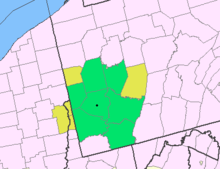Idlewild and Soak Zone
The park is home to the Ligonier Highland Games, a Scottish athletic and cultural festival that has annually drawn over 10,000 spectators.
On April 15, 1853, the Commonwealth of Pennsylvania granted a charter for a railroad to haul coal and timber between the towns of Ligonier and Latrobe.
Latrobe and Ligonier Rail Road Company performed no work on the railroad for nearly twenty years and renewed their charter in 1866 and 1869.
Following an additional renewal in 1871, the company changed its name to the Ligonier Valley Railroad and acquired a 10.3 miles (16.6 km) stretch of land.
[2][3] In 1875, the partially constructed railway was sold at a sheriff's sale after the Pennsylvania Railroad, the Latrobe terminus of the line, declined to assume financial responsibility.
Thomas Mellon, a retired Court of Common Pleas judge from Allegheny County, purchased the Ligonier Valley Railroad at auction.
[3] On May 1, 1878, William Darlington, landowner and namesake of the nearby village of Darlington, responded to Mellon's request to use his land:[3] Dear Sir: In compliance with your request, I will and do hereby agree to grant to the Ligonier Valley Rail Road Company the right and privilege to occupy for picnic purposes or pleasure grounds that portion of land in Ligonier Township, Westmoreland County as follows – the strip or piece of ground lying between the railway and the creek and extending from the old cornfield to Byards run – also two or three acres on the opposite side of the creek adjoining near the same.
Without compensation in the shape of rent for three years from the first of April 1878, provided no timber or other trees are to be cut or injured – the underbrush you may clear out if you wish to do so.
[4] Initial land development included campsites, an artificial lake for fishing and boating, picnic tables, and a large hall.
The railroad provided easy access to the site, attracting visitors from 50 miles (80 km) away in Pittsburgh and the surrounding areas for a getaway in the country.
"[6] While the initial lease with Darlington confined the park between the railroad and the north bank of the Loyalhanna Creek, permission was later granted to construct a bridge across the river, allowing expansion to the south in the mid-1880s.
The first season under the financial support of Mellon and the management of Macdonald and his family brought electricity to the park, allowing for later operating hours and electric-powered rides, including a three-row Philadelphia Toboggan Company carousel.
[9] The Macdonalds sought to maintain the park's natural beauty, planting 10,000 shrubs in the first year and thousands of trees during the 1930s.
In the first few years, the park added a circle swing, a Whip, a miniature railroad, and in 1938, the Philadelphia Toboggan Company Rollo Coaster.
[5] After leaving Idlewild, the Mellon family also abandoned the Ligonier Valley Railroad, declining after closing area coal mines and decreasing passenger traffic.
The games, held annually in early September after the park had closed for the summer, became one of the country's largest and most highly regarded Scottish athletic and cultural competitions.
"[11] The park sustained heavy damage when the remnants of Hurricane Agnes dropped 14 inches (360 mm) of rain on the area in 24 hours in June 1972.
In 1989, the park expanded across the Loyalhanna Creek by adding a trolley ride based on Mister Rogers' Neighborhood, a popular children's television show.
[5] A Ferris wheel, Tilt-A-Whirl, and a water raft ride were added by the end of the 1980s, along with games, new food stands, and restaurants.
The roller coaster was built in 1985 and had previously operated at Wiener Prater in Austria and Alton Towers in England, before opening at Idlewild in 1993.
Kennywood continued the Macdonald tradition of offering large-scale entertainment, presenting circuses, lumberjack and acrobatics shows, and stage performances at the new Hillside Theater.
In the early years of the 21st century, additions to the waterpark doubled its size and led to a new name, Idlewild and Soak Zone.
Kennywood's owners rejected offers by larger companies to purchase the group, such as in 1997 by Premier Parks, which acquired the Six Flags franchise a year later.
However, on December 11, 2007, Kennywood Entertainment announced that it would sell its parks to the Madrid-based amusement company, Parques Reunidos.
[18] Before the 2013 season, Idlewild removed its 1947 Caterpillar ride[19] and closed the Dizzy Lizzy's Saloon Haunted Swing attraction, which is currently standing but not operating.
[citation needed] During the interim time between the 2013 and 2014 seasons, it was announced that the park had permanently closed its popular attraction, Mister Rogers' Neighborhood of Make-Believe.
Built in 1947, Idlewild's model was one of three similar rides still in operation in North America, one of two featuring a working canopy that covers the riders, and the only one that still utilized an undercarriage fan.
Some of the older rides at the park were the Circle Swing which sat where the Super Round-Up sits today; this was a trio of stainless steel rocket ship gondolas that, when powered, swung over the Loyalhanna giving the illusion you were about to fly into the trees.
Built in 1989, the 3 ft (914 mm) narrow gauge trolley ride was designed specifically for Idlewild by local native Fred Rogers and is based on his popular children's television show.
[13] Before the 2014 season, it was announced that the ride would be re-themed in coordination with Fred Rogers Productions to their modern children's show, Daniel Tiger's Neighborhood (2012-), based on the original series.






